Gas processing news
H. Meche, Associate Editor
GE reaches LNG project milestone
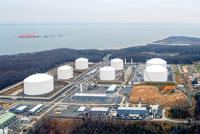 |
GE Oil & Gas has shipped two LNG compressor trains that are being supplied for the development of Dominion’s Cove Point LNG export facility, currently under construction by IHI E&C International Corp. and Kiewit Energy Co. The LNG plant, located on Chesapeake Bay in Lusby, Maryland, will produce approximately 5.25 metric MMtpy of LNG when completed in late 2017, and it will be the first LNG terminal capable of exporting LNG from the US East Coast.
Each of the two identical trains includes an FR7 gas turbine plus three centrifugal compressors and a 20-MW, two-pole induction electric helper motor provided by GE’s Power Conversion business.
The JV team of IHI E&C International Corp. and Kiewit Energy Co. will provide Dominion Resources with EPC services to convert the existing LNG import terminal into an LNG liquefaction plant for the export of LNG to India and Japan.
GE will also provide two auxiliary trains for Dominion’s Cove Point LNG project—one for the lean gas compression service composed of one centrifugal compressor with a gear box and a 27-MW synchronous motor, and one for the propane recovery service with one reciprocating compressor.
Separation technology achieves standards
The development and industrial applications of methanol-to-olefins (MTO) separation technology undertaken by Wison Engineering Ltd. has passed scientific and technological appraisal conducted by the China Petroleum and Chemical Industry Association (CPCIA). The appraisal results show that Wison Engineering’s proprietary MTO separation technology has reached advanced international standards and is highly competitive in the market.
The experts concluded that Wison Engineering’s MTO separation technology is innovative and advanced in comparison to similar technologies both in China and overseas, as it is said to
be the first to apply precutting and oil absorption technology to the separation of MTO
reaction byproducts.
It also adopts a downward film heat exchanger for transferring heat and materials simultaneously during the oil absorption process. It can be widely used in MTO plants and has good potential for other applications. Furthermore, the appraisal shows that, when compared to imported technologies in use, Wison Engineering’s MTO separation technology increases ethylene yield by 1%.
MOU signed to expand Nord Stream pipeline
 |
BASF subsidiary Wintershall will participate in expanding the capacities of the Nord Stream pipeline, which delivers Russian natural gas to European customers via the Baltic Sea. An MOU to this effect has been signed. The expansion of the Nord Stream pipeline will consist of two additional pipelines that will be able to transport up to an additional 55 Bcm of Russian gas directly to Germany.
In addition to Gazprom, E.ON, OMV and Shell have declared their intention to participate in the construction of the two additional lines of the Nord Stream pipeline.
The first two lines of Nord Stream, in which the BASF subsidiary Wintershall has a 15.5% stake, have been operational since October 2012. The Russian gas arrives at the mainland in Lubmin, Germany, on the Baltic Sea coast, and is transported from there via the two connecting pipelines, OPAL (Ostsee-Pipeline-Anbindungs-Leitung—the Baltic Sea Pipeline Link) and NEL (Nordeuropäische Erdgasleitung—the North European Gas Pipeline), to customers in West and Central Europe.
The existing pipelines already make a vital contribution to strengthening supply security and meeting long-term demand for natural gas imports in Germany and Europe. The EU’s import requirements are expected to rise further, since the gap between the production and consumption of natural gas continues to grow. The IEA forecasts that European gas production will fall by about 2%/yr, while consumption will rise by 0.6%/yr.
Delfin awards FLNG FEED work
 |
Bechtel has been selected by Delfin LNG, a wholly owned subsidiary of Fairwood Peninsula Energy Corp., to perform FEED for the first US-based FLNG vessel to go into service at Port Delfin. The proposed deepwater port and FLNG facility will be located approximately 50 mi off the coast of Cameron Parish, Louisiana.
Delfin LNG’s project will be the first offshore floating natural gas liquefaction facility in the US. Upon the final investment decision, Bechtel is expected to design, build and commission the FLNG vessel. Port Delfin will receive natural gas from the Delfin Offshore Pipeline.
The FLNG vessel will be able to disconnect from the port facility and move to protected waters during a hurricane. The offshore location of the port will significantly reduce coastal LNG carrier traffic and minimize nearshore environmental impacts, according to project officials.
NEB approves Orca LNG license
Canada’s National Energy Board (NEB) has approved Orca LNG Ltd.’s application for a 25-year natural gas export license with a maximum-term quantity of 901 Bcm. The issuance of this license is subject to the approval of the governor in council.
When evaluating natural gas and LNG export license applications, the NEB considers if the quantity of gas proposed to be exported is surplus to Canadian requirements, taking into account trends in the discovery of gas in Canada.
The NEB has determined that the quantity of gas proposed to be exported by Orca LNG is surplus to Canadian needs. The NEB is satisfied that Canada’s gas resource base, and the overall gas resource base in North America, is large and can accommodate reasonably foreseeable Canadian demand. This demand would include the LNG exports proposed by Orca LNG, as well as a potential increase in Canadian demand.
FEED contract awarded for Browse FLNG
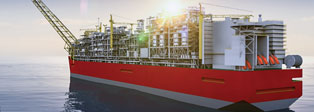 |
The Wood Group has secured a new contract to carry out FEED for the Woodside-operated Browse FLNG development offshore Western Australia.
Wood Group Kenny (WGK) will perform all design engineering for the insulated production flowline system required for the asset’s offshore gas condensate fields (Brecknock, Calliance and Torosa) located 300 km from the Kimberly coast. The 12-month contract, which is valued at $6 MM and effective immediately, will be delivered from WGK’s Perth office.
Excelerate moves on LNG terminal
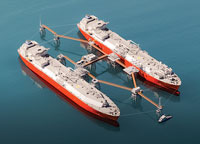 |
The US Federal Energy Regulatory Commission (FERC) has granted authorization to Excelerate Energy, in cooperation with the Puerto Rico Electric Power Authority (PREPA), to site, construct and operate the proposed Aguirre Offshore GasPort Project located offshore Puerto Rico. The order confirms the final environmental impact statement (EIS) that resulted in a finding of no significant environmental impact. As part of the order, the project will comply with all of the environmental conditions outlined by FERC.
The proposed project will be an LNG terminal with the same capabilities as a land-based terminal. The terminal will consist of a floating storage and regasification unit (FSRU), minimal infrastructure to moor the vessel and a subsea pipeline to deliver the gas onshore. The facility will provide fuel to PREPA’s Central Aguirre Power Complex. Fuel cost reduction and environmental improvements, such as better air quality and reduced barge traffic in the environmentally sensitive Jobos Bay, are the primary drivers for bringing the project
to Puerto Rico.
The project has undergone a comprehensive analysis through the environmental review process that began in December 2011. Within this time frame, Excelerate has provided extensive information regarding the design, construction and operation of the project to FERC, cooperating agencies, and the general public.
On February 20, 2015, FERC issued the final EIS, which assessed the environmental impacts of the project and determined that the project was suitable for construction and operation.
Excelerate will continue to work with FERC and cooperating agencies in preparation for the commencement of construction. Construction is estimated to begin in the first quarter of 2016, with an in-service date of the second quarter of 2017.
Marine study of Monkey Island project
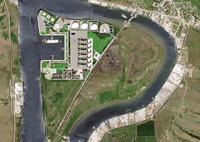 |
As the next step in its Monkey Island LNG Project in Cameron Parish, SCT&E LNG Inc. has contracted Proes to evaluate the location’s marine infrastructure. Proes, a Spanish marine and environmental consultancy contractor, will develop a waterway suitability assessment (WSA), which it will submit to the US Coast Guard upon completion.
In addition to the WSA, Proes will draw from its extensive experience with LNG and marine infrastructure to assist SCT&E with the prefiling processes for the US Federal Energy Regulatory Commission (FERC).
SCT&E plans to liquefy about 1.62 Bcfd of natural gas, from which it will produce 12 metric MMtpy of LNG. The US Department of Energy has given the company permission to export up to 12 metric MMtpy to countries that adhere to free trade agreements.
Cheniere starts Sabine Train 5 construction
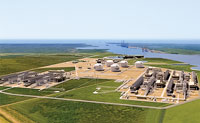 |
In order to fund Train 5 construction, Cheniere Partners’ wholly owned subsidiary, Sabine Pass Liquefaction LLC, has entered into four credit facilities, which replace its existing credit facilities, for the incurrence of debt up to an aggregate amount of approximately $4.6 B.
Cheniere owns 100% of the Sabine Pass LNG terminal located on the Sabine Pass deepwater shipping channel less than 4 mi from the Gulf Coast. The Sabine Pass LNG terminal includes existing infrastructure of five LNG storage tanks with capacity of approximately 16.9 Bcfe, two docks that can accommodate vessels with nominal capacity of up to 266 Mcm, and vaporizers with regasification capacity of approximately 4 Bcfd.
Cheniere is developing gas liquefaction facilities at the Sabine Pass LNG terminal adjacent to the existing regasification facilities. The company plans to construct up to six liquefaction trains, which are in various stages of development. Each liquefaction train is expected to have a nominal production capacity of approximately 4.5 MMtpy.
The overall project completion percentage of Trains 1 and 2 is approximately 90.8% as of mid-2015. The overall project completion percentage of Trains 3 and 4 is approximately 67.7% as of mid-2015. Construction commenced on Train 5 in June. Cheniere has received all regulatory approvals to construct and operate Train 6.
Next-generation LNG carrier concept
GasLog Ltd. has announced the completion of the LNGreen joint industry project (JIP). The LNGreen JIP brought together experts from GasLog, DNV GL, GTT and Hyundai Heavy Industries (HHI) to develop a state-of-the-art, next-generation LNG carrier.
Each of the project partners contributed their unique know-how and experience to develop the LNG carrier, using the latest shipbuilding technology available. The vessel concept has an improved environmental footprint, a higher level of energy efficiency, an improved boiloff rate and improved cargo capacity. The application of two-stroke propulsion technology makes the vessels well suited to future LNG trading patterns.
The LNGreen project focused on improving the efficiency and performance of the modern LNG carrier by analyzing actual operational performance data, focusing on further optimization through reassessment of vessel hydrodynamics, machinery and systems configuration. These improvements will lead to greater efficiency and cargo capacity without any compromise to the safety or quality of the vessels.
The outcome of the project is a concept design that is close to 10% more energy efficient, and with an increased cargo capacity of approximately 5%.
Technology chosen for Golar FLNG
Engaged by Keppel Shipyard Ltd. for a third time in just over 12 months, Black & Veatch will team with the Singaporean company to convert a Golar LNG carrier, the GANDRIA, into a Golar floating liquefaction facility (GoFLNG).
In July 2014, Black & Veatch announced its contract for the similar conversion of the HILLI. Following that, the companies joined together again in December 2014 to announce another effort that would convert the GIMI into a GoFLNG facility. Black & Veatch had also worked with Golar in early 2012 on the concept and front-end design for FLNG vessel conversions.
The work scope for Keppel Shipyard and Black & Veatch to convert the GANDRIA is similar to that of the two earlier projects. Black & Veatch will provide its PRICO liquefaction technology, as well as perform detailed engineering and process design, specify and procure topside equipment, and provide commissioning support for the GoFLNG GANDRIA topsides and liquefaction process. Keppel Shipyard will provide the design, detailed engineering and procurement of the marine systems, and all of the conversion-related construction services.
Similar to the GIMI, full construction activities of the GANDRIA will only commence after receiving a notice to proceed, which is expected in 2016.




Comments